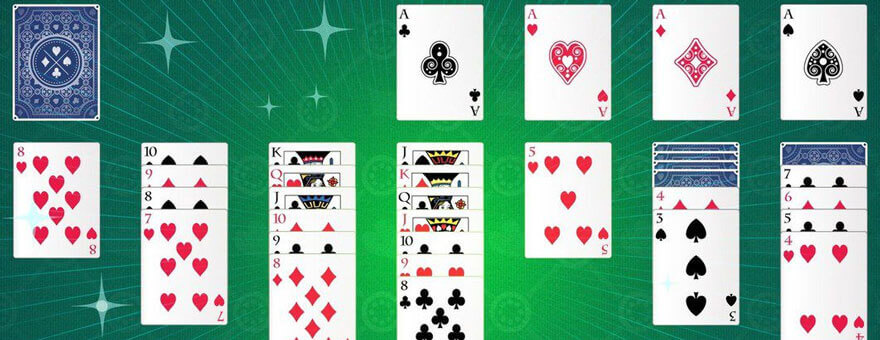
Most Popular Types of Solitaire

Klondike Solitaire is probably the most popular version of Solitaire. Often times, it’s also referred to as Fascination, or Demon Patience. Here you initially deal out 28 cards into seven piles, in the following manner: The first pile (left to right) includes one card, the second pile includes two cards, the third pile includes three cards, and so on and so forth - up until the last pile that should have has seven cards. The top card on each pile is also on a face-up position, giving you 7 face-up cards ready to get sequenced from the start of the game. The remainder of cards upon completing the initial puzzle sequence also becomes your draw pool in the game.
Draw out a card from your pool one at a time (alternatively, you may draw multitudes of cards at a time to heighten the challenge). If the card you reveal from the pool is playable (either on the foundation/pile or the tableau/puzzle), you may do so. If not, add it to a face-up discard pile. The top card on the discard pile is always available to be played.
Next, we have Pyramid (also known as Solitaire 13). A solitaire game with very simple rules and takes just a few minutes to play each session. It also (most likely) got its name from the relative form of the initial deal of cards to be played. In this version of Solitaire, you deal the cards forming a pyramid, starting with a row of 1 card, followed by a row of two cards until you get down to a row of 7 cards. Upon being dealt with the whole pyramid, it will include a total of 28 cards - leaving you with 24 cards set on a facedown position to serve as your draw pool.
In this game, you reveal the cards from the draw pool, one at a time. If a card from the pool is not used, it should be covered up by the next card you draw. It can be used later in the game, but only if it gets uncovered because any drawn out cards on top of it can't be discarded. When two exposed cards gets you a total of 13 (with their value), they are discarded (most likely the reason why Pyramid Solitaire is sometimes referred to as Solitaire 13). It is to note too that discarding is always optional, and there may be times when it is a better tactical choice not to discard.
Another commonly seen version of Solitaire is the Golf Solitaire. In this game, players try to earn the lowest number of points (like that of the "golf" sport where it most likely got its name) over the course of nine deals. To start a game, you must initially arrange your standard 52-card deck, dealing out 7 columns with 5 cards, all of which are dealt in a face-up position. One additional card is dealt as the base of the foundation. The remaining 16 cards are turned face down to form the pool of draw cards (or stock).
To play Golf, only the topmost card in each column may be removed from the puzzle. When a card is successfully sequenced and removed from the column, the card beneath becomes available for play. Cards may be moved from the tableau to the foundation if they are either one rank higher or one rank lower than the top card of the foundation (which is the most sought after mechanic of the game, as seen across many Facebook Solitaire games), regardless of suit, but nothing may be played on top of a King. Meaning, cards are ranked from Ace to King with no overlapping of figures like Ace on a King, or King on an Ace. Whenever there are no possible plays, turn cards up one at a time from the draw pool to the foundation and resume playing cards from the tableau when possible. The game is over when your draw pool is exhausted and no more moves are available.
We hope that you'll find good use of this article, to get you the games that would ultimately teach you the basics of these common solitaire games. Until then, we wish you a great time playing these Solitaire puzzles!












